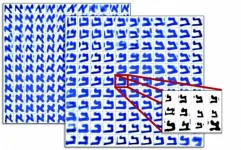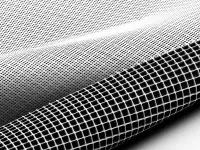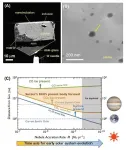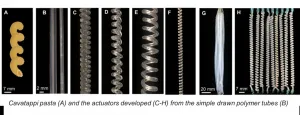(Press-News.org) The Dead Sea Scrolls, discovered some seventy years ago, are famous for containing the oldest manuscripts of the Hebrew Bible (Old Testament) and many hitherto unknown ancient Jewish texts. But the individual people behind the scrolls have eluded scientists, because the scribes are anonymous. Now, by combining the sciences and the humanities, University of Groningen researchers have cracked the code, which enables them to discover the scribes behind the scrolls. They presented their results in the journal PLOS ONE on 21 April.
The scribes who created the scrolls did not sign their work. Scholars suggested some manuscripts should be attributed to a single scribe based on handwriting. 'They would try to find a "smoking gun" in the handwriting, for example, a very specific trait in a letter which would identify a scribe', explains Mladen Popović, professor of Hebrew Bible and Ancient Judaism at the Faculty of Theology and Religious Studies at the University of Groningen. He is also director of the university's Qumran Institute, dedicated to studying the Dead Sea Scrolls. However, these identifications are somewhat subjective and often hotly debated.
Scribes
That is why Popović, in his project The Hands that Wrote the Bible which was funded by the European Research Council, teamed up with his colleague Lambert Schomaker, professor of Computer Science and Artificial Intelligence at the Faculty of Science and Engineering. Schomaker has long worked on techniques to allow computers to read handwriting, often from historical materials. He also performed studies to investigate how biomechanical traits, like the way in which someone holds a pen or stylus, would affect handwriting.
In this study, together with PhD candidate Maruf Dhali, they focused on one scroll in particular: the famous Great Isaiah Scroll (1QIsaa) from Qumran Cave 1. The handwriting in this scroll seems near-uniform, yet it has been suggested it was made by two scribes sharing a similar writing style. So how could this be decided? Schomaker: 'This scroll contains the letter aleph, or "a", at least five thousand times. It is impossible to compare them all just by eye.' Computers are well suited to analyse large datasets, like 5,000 handwritten a's. Digital imaging makes all sorts of computer calculations possible, at the microlevel of characters, such as measuring curvature (called textural), as well as whole characters (called allographic).
Neural network
'The human eye is amazing and presumably takes these levels into account too. This allows experts to "see" the hands of different authors, but that decision is often not reached by a transparent process,' Popović says. 'Furthermore, it is virtually impossible for these experts to process the large amounts of data the scrolls provide.' That is why their results are often not conclusive.
The first hurdle was to train an algorithm to separate the text (ink) from its background (the leather or the papyrus). For this separation, or 'binarization', Dhali developed a state-of-the-art artificial neural network that can be trained using deep learning. This neural network keeps the original ink traces made by the scribe more than 2,000 years ago intact as they appear on the digital images. 'This is important because the ancient ink traces relate directly to a person's muscle movement and are person-specific', Schomaker explains.
Similarities
Dhali performed the first analytical test of this study. His analysis of textural and allographic features showed that the 54 columns of text in the Great Isaiah Scroll fell into two different groups that were not distributed randomly through the scroll, but were clustered, with a transition around the halfway mark.
With the remark that there might be more than one writer, Dhali then handed the data to Schomaker who then recomputed the similarities between the columns, now using the patterns of letter fragments. This second analytical step confirmed the presence of two different. Several further checks and controls were performed. Schomaker: 'When we added extra noise to the data, the result didn't change. We also succeeded in demonstrating that the second scribe shows more variation within his writing than the first, although their writing is very similar.'
Handwriting
In the third step, Popović, Dhali, and Schomaker have produced a visual analysis. They created 'heat maps' that incorporate all the variants of a character across the scroll. Then they produced an averaged version of this character for the first 27 columns and the last 27 columns. Comparing these two average letters by eye shows that they are different. This links the computerized and statistical analysis to human interpretation of the data by approximation, because the heatmaps are neither dependent nor produced from the primary and secondary analyses.
Certain aspects of the scroll and the positioning of the text had led some scholars to suggest that after column 27 a new scribe had started, but this was not generally accepted. Popović: 'Now, we can confirm this with a quantitative analysis of the handwriting as well as with robust statistical analyses. Instead of basing judgment on more-or-less impressionistic evidence, with the intelligent assistance of the computer, we can demonstrate that the separation is statistically significant.'
New window
In addition to transforming the palaeography of the scrolls - and potentially other ancient manuscript corpora - this study of the Great Isaiah Scroll opens up a totally new way to analyse the Qumran texts based on physical characteristics. Now, researchers can access the microlevel of individual scribes and carefully observe how they worked on these manuscripts.
Popović: 'This is very exciting, because this opens a new window on the ancient world that can reveal much more intricate connections between the scribes that produced the scrolls. In this study, we found evidence for a very similar writing style shared by the two Great Isaiah Scroll scribes, which suggests a common training or origin. Our next step is to investigate other scrolls, where we may find different origins or training for the scribes.'
In this way, it will be possible to learn more about the communities that produced the Dead Sea Scrolls. 'We are now able to identify different scribes', Popović concludes. 'We will never know their names. But after seventy years of study, this feels as if we can finally shake hands with them through their handwriting.'
INFORMATION:
Additional information:
Digital images of the Dead Sea Scrolls and of the Great Isaiah Scroll were kindly provided by Brill Publishers and the Israel Antiquities Authority (the Leon Levy Dead Sea Scrolls Digital Library).
From 6-8 April 2021 an international online conference took place, Digital Palaeography and Hebrew/Aramaic Scribal Culture, organized by the University of Groningen. A link to presentations will appear soon on this page: https://www.rug.nl/ggw/news/events/2021/digital-palaeography-and-hebrew-aramaic-scribal-culture
Reference: Mladen Popović, Maruf A. Dhali, and Lambert Schomaker, Artificial Intelligence Based Writer Identification Generates New Evidence for the Unknown Scribes of the Dead Sea Scrolls Exemplified by the Great Isaiah Scroll (1QIsaa)
Floodwaters are not what most people consider a blessing. But they could help remedy California's increasingly parched groundwater systems, according to a new Stanford-led study. The research, published in Science Advances, develops a framework to calculate future floodwater volumes under a changing climate and identifies areas where investments in California's aging water infrastructure could amplify groundwater recharge. As the state grapples with more intense storms and droughts, stowing away floodwaters would not only reduce flood risks but also build more water reserves for ...
Addressing a much-debated question about the impact of stress on survival in wild, nonhuman primates, a new multi-decadal study involving 242 wild female baboons found evidence to support chronic stress as a significant factor affecting survival. The study found that a female baboon with a stress response - as reflected in fecal glucocorticoid concentrations, a biomarker of stress response - in the top 90% for her age throughout adulthood was expected to lose 5.4 years of life compared to a female with glucocorticoid concentrations in the bottom 10% for her age group. The findings, which leveraged more than 14,000 fecal glucocorticoid measurements over a ...
MADISON, Wis. -- Tens of millions of people worldwide are affected by diseases like macular degeneration or have had accidents that permanently damage the light-sensitive photoreceptors within their retinas that enable vision.
The human body is not capable of regenerating those photoreceptors, but new advances by medical researchers and engineers at the University of Wisconsin-Madison may provide hope for those suffering from vision loss. They described their work today in the journal Science Advances.
Researchers at UW-Madison have made new photoreceptors from human pluripotent stem cells. However, it remains challenging to precisely deliver those photoreceptors within the diseased or damaged eye so that ...
Water is abundant in our solar system. Even outside of our own planet, scientists have detected ice on the moon, in Saturn's rings and in comets, liquid water on Mars and under the surface of Saturn's moon Enceladus, and traces of water vapor in the scorching atmosphere of Venus. Studies have shown that water played an important role in the early evolution and formation of the solar system. To learn more about this role, planetary scientists have searched for evidence of liquid water in extraterrestrial materials such as meteorites, most of which originate from asteroids that formed in the early history of the solar system.
Scientists have even found water as hydroxyls and molecules in meteorites in the context ...
Two of the COVID-19 vaccines currently approved in the United States require two doses, administered three to four weeks apart, however, there are few data indicating how best to minimize new infections and hospitalizations with limited vaccine supply and distribution capacity. A study published on 21st April, 2021 in the open access journal PLOS Biology by Seyed Moghadas at York University in Toronto, Canada, and colleagues suggests that delaying the second dose could improve the effectiveness of vaccine programs.
The emergence of novel, more contagious SARS-CoV-2 variants has led to a public health debate on whether to vaccinate more individuals with the first ...
Swing voters in battleground states delivered Donald Trump his unexpected victory in the 2016 presidential election, suggests a new study coauthored by Yale political scientist Gregory A. Huber.
The study, published on April 21 in the journal Science Advances, compares the outcomes of the 2012 and 2016 presidential elections in six key states: Florida, Georgia, Michigan, Nevada, Ohio, and Pennsylvania. The analysis merged voter turnout records of 37 million individuals with precinct-level election returns to determine the sources of Trump's electoral success. It examined the relative roles of conversion -- voters switching their support from one party to the ...
Boston, MA - In a worldwide survey, pregnant and postpartum women reported high levels of depression, anxiety, loneliness, and post-traumatic stress during the COVID-19 pandemic, according to researchers at Harvard T.H. Chan School of Public Health. Such high levels of distress may have potential implications for women and for fetal and child health and development, according to the study.
The study will be published online in PLOS ONE on April 21, 2021.
"We expected to see an increase in the proportion of pregnant and postpartum women reporting mental health distress, as they are likely to be worried or have questions about their babies' health and development, ...
In the field of robotics, researchers are continually looking for the fastest, strongest, most efficient and lowest-cost ways to actuate, or enable, robots to make the movements needed to carry out their intended functions.
The quest for new and better actuation technologies and 'soft' robotics is often based on principles of biomimetics, in which machine components are designed to mimic the movement of human muscles--and ideally, to outperform them. Despite the performance of actuators like electric motors and hydraulic pistons, their rigid form limits how they can be deployed. As robots transition to more ...
Researchers of the University of Barcelona, together with researchers from the University of Zurich (Switzerland) and Brown University (United States), have analysed more than 10,000 evaluations that were carried out to candidates who wish to hold a public teaching permanent in Catalonia. The objective was to study how the decision by the committee of evaluators is affected by the fact that each candidate holds a certain position in the lists of people to be assessed. The study, published in the journal Science Advances, identifies a new cognitive bias that researchers have named "generosity-erosion effect". It involves that once the evaluators have scored one candidate generously, ...
Brandi Wren was studying social distancing and infections before masking tape marks appeared on the grocery store floor and plastic barriers went up in the post office.
Wren, a visiting scholar in the Department of Anthropology at Purdue University, spent a year studying wild vervet monkey troops in South Africa, tracking both their social grooming behavior and their parasite load. Her results, some of which were published Wednesday (April 21) in PLOS ONE showed evidence that monkeys carrying certain gastrointestinal parasites do not groom others as much as those without the parasite, and that routes of transmission may not be as clear cut as biologists think.
With implications for both animal behavior and human health, Wren's results open new avenues for research and ...






